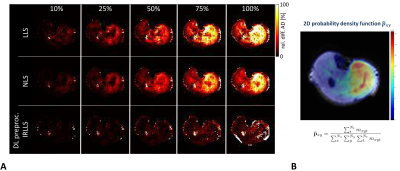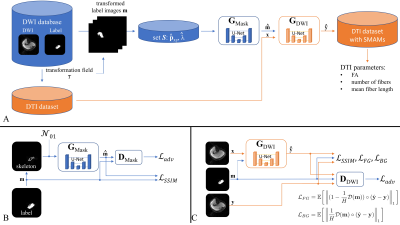Martin Schwartz1,2, Petros Martirosian1, Günter Steidle1, Bin Yang2, and Fritz Schick1
1Section on Experimental Radiology, University Hospital of Tuebingen, Tuebingen, Germany, 2Institute of Signal Processing and System Theory, University of Stuttgart, Stuttgart, Germany
1Section on Experimental Radiology, University Hospital of Tuebingen, Tuebingen, Germany, 2Institute of Signal Processing and System Theory, University of Stuttgart, Stuttgart, Germany
Simulation
of spontaneous muscular activities and their influence on derived diffusion
parameters is investigated by a model-based approach for simulation and preprocessing.

Figure 5: A: Axial diffusivity maps for LLS, NLS and the
model-based preprocessing approach and for different amounts of SMAM-affected
DTI (from 10% to 100%). B: 2D probability density function
for the location of the SMAM occurrences in the right lower leg. The
high activity rate is reflected by large deviations in the AD maps in the
region of m. soleus and m. gastrocnemius medialis.

Figure
1: A: Concept for SMAM generation and insertion into
an undistorted DTI data set. SMAM activity rate
and location
can be
estimated from DWI and transferred on the DTI data sets. B: Training of
the mask generator with a skeletonized label mask m and Gaussian noise. C:
Training of the generator for SMAM insertion with a separated background
and foreground loss to preserve background signal intensity.